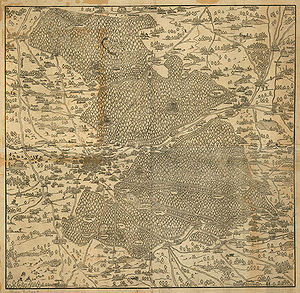
Nuremberg is first documented in writing in 1050 as an Imperial Castle in the middle of a large imperial estate complex. The rise of the city began in the 12th century under the Hohenstaufen dynasty. In 1219, the citizens of Nuremberg were granted their first comprehensive city privilege. In the further course of the 13th century, municipal self-administration was established and Nuremberg became an imperial city only subordinate to the head of the empire. In addition to this, Nuremberg always maintained a special relationship with royalty (e.g. Golden Bull, Imperial Regalia). The Hohenzollern burgraves were forced out of the city between 1385 and 1427. Thanks to an alliance with Bavaria-Munich, Nuremberg was able to significantly expand its territory in 1505. Between the end of the 15th and the beginning of the 16th century, Nuremberg flourished on the basis of craftsmanship and trade. At the same time, the city progressively ossified in a rigid system of five strictly separated social classes. In 1525, Nuremberg was the first imperial city to implement the Reformation. The city had great difficulties recovering from the devastation of the Thirty Years' War. Simultaneously, the imperial city's society and legal system came to a standstill, as the city became increasingly indebted in the 17th and 18th centuries. It was not until the 1790s that reforms were able to be achieved with imperial help, but these couldn’t develop an effective impact before the city’s annexation by Bavaria in 1806.
Beginnings as an Imperial Castle around 1050
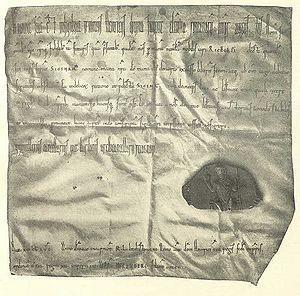
The City of Nuremberg was established around the turn of the 11th century based on an Imperial Castle first mentioned in 1050 in the midst of an extensive imperial estate complex in Eastern Franconia and Bavarian Nordgau. The Salian and Hohenstaufen rulers preferred this prominent site and gradually expanded it. Heinrich III (ruled 1030-1056), for example, transferred the market rights from the neighbouring royal court Fürth, which dated back to Carolingian times, to his new base soon after 1050. Shortly afterwards, his son Heinrich IV (ruled 1056-1084) removed the imperial estate around Nuremberg from the county of Hirschberg/Sulzbach, which belonged to the Bavarian Nordgau, and turned it into a separate high court and administrative district of the empire. This essentially comprised the two Nuremberg imperial forests as well as some clearings and expansion settlements north, east and south of the city, which was later to be part of the Alte Landschaft, the foundation of the Nuremberg territory.
Nuremberg during the Hohenstaufen period – development of the burgraviate
The rise of the city started under Konrad III (ruled 1138-1152) before the middle of the 12th century: He built the burgraviate with court and administration over Nuremberg and the surrounding imperial estate. The burgraves initially came from the Austrian House of the Lords of Raab and after 1190/92 from the Swabian House of Hohenzollern, who later rose to be the greatest territorial lords in the region as the Margraves of Ansbach and Kulmbach/Bayreuth. However, after 1200 until the Interregnum their office as Burgrave of Nuremberg was restricted to purely military matters, whilst the management of the imperial estate and the royal district court that met before the St. Egidien church was incumbent on an independent official (cup-bearer), whose office the burgraves were able to take over until 1282. The administration of the town and the municipal court was headed by a "Reichsschultheiß" (reeve, bailiff sheriff), which is first documented in 1173/74.
The increasing demand of the royal court and the growing importance of the city attracted more and more craftsmanship and trade to Nuremberg. The Hohenstaufen rulers promoted both. For example, Friedrich II (ruled 1212-1250) decreed the "Greater Privilege" in 1219, a first comprehensive city privilege that placed the citizens of Nuremberg under his sole protection and guaranteed them advantages in monetary and customs policy.
Rise to imperial city – links to royalty – internal unrest
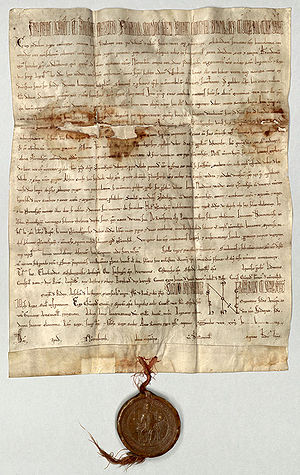
The evolution from the 11th century seat of the king to the 13th century Imperial City was roughly completed around 1250. Attempts by the House of Hohenzollern and Wittelsbach to alienate the city from the empire after the downfall of the Hohenstaufen rulers, were thwarted by Rudolf von Habsburg (ruled 1273-1291) – although with considerable concessions to the Hohenzollern burgraves. The Nuremberg citizenship already appeared as a legal community in the "Greater Privilege". It was first attested as "universitas civium" in 1256 and had its own seal from 1236/42 onwards.
In the 14th century, the city received enormous support from Ludwig der Bayer (ruled 1314-1347; among other things, extensive customs privileges) and Karl IV. (ruled 1347-1378). The latter elevated Nuremberg to the place where every newly elected king was to hold his first Imperial Diet in his Golden Bull of 1356. As a result, Nuremberg became the third city legally associated with royalty under imperial law, alongside Frankfurt am Main, the location for the election, and Aachen as the place of the coronation of kings. The links to royalty and the empire were strengthened when King Sigismund (ruled 1411-1437) entrusted Nuremberg with storing the Imperial Regalia for eternity in 1423. They remained in Nuremberg until 1796, when they were ushered away in the face of advancing French troops via Regensburg to Vienna, where they found a new home.
Under Karl IV, Council members, supported by craftsmen and merchants, revolted against the Old Council in the so-called Craftmen’s Uprising in 1348/49. The uprising mainly had political reasons, because in the dispute between Emperor Ludwig's heirs and Karl IV the seditious councilmen took the Wittelsbachs' side against the old Council, which supported Karl IV. The result of the craftsmen's uprising was a permanent ban on any kind of self-organisation of craftsmen, which was commonly allowed in other imperial cities' Guild constitutions.
After the suppression of the rebellion, Karl IV tolerated the destruction of the Nuremberg Jewish quarter in 1349 in the course of the great Plague epidemic – even though it had spared Nuremberg – constituting the second largest pogrom of the Jews in Nuremberg after the so-called Rintfleisch pogrom (transl. „Beef“ pogrom) in 1298. 562 Jews were burned. The Jewish quarter had to make way for today's main market and fruit market, and Karl IV had the Frauenkirche (Women’s Church) built on the foundations of the synagogue. Shortly thereafter, Jewish people settled in the imperial city again until they were expelled from the city entirely, following a royal privilege in 1499. It was not until 1850 that citizens of the Mosaic faith found a home in Nuremberg again.
Disputes with the Hohenzollern
The power and reputation of the Franconian metropolis were now so solidified that the Council and citizenship could hope to resolve the growing tensions with the House of Hohenzollern. The burgraves, who were in the meantime promoted to the rank of Princes of the Empire, were gradually forced out of the city and in parts the imperial city's immediate vicinity between 1385 and 1427. However, when purchasing the Burgrave’s Castle and the imperial forests in 1427, the Council did not succeed in acquiring all the sovereign rights from the House of Hohenzollern, such as officiating the Court of High Justice, the high hunt and the escort outside the city. Therefore, until the end of Nuremberg's Imperial immediacy, there were still enough reasons for serious disputes of judicial, but also warlike nature between the two neighbours, for instance as early as 1449/50 in the First Margraves War.
Alliance with Bavaria-Munich, territorial gains in 1505
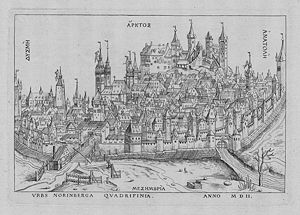
Around the middle of the 15th century, the hostility with the House of Hohenzollern gave rise to an alliance with the Wittelsbach dukes of Bavaria-Munich. As a result, the imperial city conquered the towns and offices of Altdorf, Lauf, Hersbruck, Hohenstein, Reicheneck und Velden, which belonged to Bavaria-Landshut or the Electoral Palatinate in the Landshut War of Succession in 1504/05. The Cologne Peace Treaty confirmed this territorial gain. With an area of approx. 1,200 square kilometres east of the city, the Council thus gained the largest land territory governed by an imperial city .
Cultural and economic heyday in the 15th and 16th century
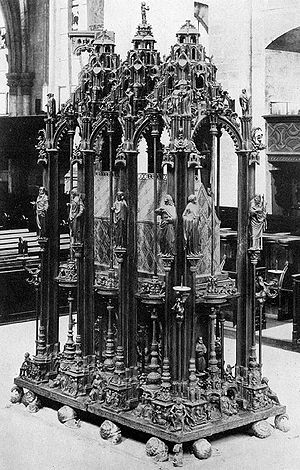
With the ousting of the burgraves from the city, Nuremberg's great heyday began. The prerequisite for freedom and a cultural bloom was the city’s wirtschaftliche Reichtum, which rested on two pillars: the long-distance trade of the Nuremberg patricians or its merchants and the industriousness and skill of its craftsmen.
The pursuit of "city saints" was characteristic for the self-image of the city and its leading citizens. Vigorously pushed by the Council, Sebald was canonized in 1425 by Pope Martin V (ruled 1417-1431). The silver reliquary casket with the bones of the saint set up in St. Sebaldus Church in 1397 was encased in a bronze structure by Peter Vischer (around 1460-1529) in 1519. A similar attempt was made with Deocarus, the first abbot of the Herrieden (798-832) Benedictine monastery, whose bones King Ludwig der Bayer had transferred to Nuremberg in 1316. Following the cult of Sebaldus, the Council cultivated the worship of Deocarus in St. Lorenz Church, the city's second main church.
The social and legal order, which had been cemented by the Reformation at the latest (in 1521 the patricians sealed themselves off from the rest of the city population with the enactment of the so-called Dance Statute), as well as a prosperity based on increasing trade volumes and growing industry, formed the basis for a flourishing of the city’s cultural life that lasted from the 1st quarter of the 15th century until around 1630.
Nuremberg not only exported goods but also handicraft culture. The importance of its craftsmen artists is signified by names such as Albrecht Dürer (1471-1528), Veit Stoß (around 1447-1533), Peter Vischer and Adam Kraft (around 1460-1508/09). Humanism and the Renaissance shaped this great era: Konrad Celtis (1459-1508) was crowned as a poet by Emperor Friedrich III (ruled 1440-1493) in Nuremberg, the patrician son Melchior Pfinzing (1481-1535) Emperor Maximilian‘s (ruled 1486/93-1519) autobiographical epic "Teuerdank". Johannes Regiomontanus (1436-1476) used Nuremberg instruments in Nuremberg to calculate the movements of the stars; the patrician Martin Behaim (1459-1506), who commissioned the first preserved terrestrial globe, made Regiomontanus' findings useful for Portuguese shipping. The doctor Hartmann Schedel (1440-1514) attempted to provide a summary overview of world history with his World Chronicle in 1493. Willibald Pirckheimer‘s (1470-1530) correspondence with the scholars of the Christian world at that time still documents the central position of Nuremberg in the 15th and 16th century intellectual life.
Reformation in 1525
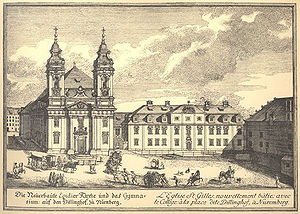
Nuremberg was the first imperial city to introduce the Reformation, doing so in 1525. The Nuremberg monasteries were abolished in the wake of this ecclesiastical reform. In the former Scottish monastery of St. Egidien, the first Nuremberg grammar school was set up at the suggestion of Philipp Melanchthon (1497-1560) whilst the remaining monastery buildings were transferred to the imperial city's offices or charitable institutions. Only the Teutonic Order commendam, subordinate directly to the empire, survived the Reformation, although they had to abandon their former commendam church of St. Jacob. The Reformation was naturally also extended to Nuremberg's land territory. The monasteries there were also secularised.
Even the tense relationship with the rival margraves was temporarily eased by the Reformation: working together on the Reformation Imperial Diets of Speyer and Augsburg in 1529 and 1530 culminated in the joint Nuremberg-Brandenburg Church Constitution of 1533. But just 20 years later the old conflict broke out with renewed vehemence across the imperial city’s territory in the Second Margrave War of 1552-1554.
Late blossoming of culture around 1600
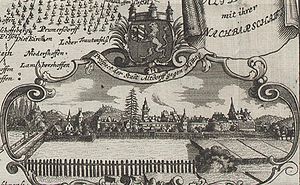
However, the renewed disputes with the neighbouring margrave did little to stop the cultural and economic bloom of the Franconian metropolis. In Altdorf, the city founded an academy in 1575, which was raised to university status in 1622/23. In the late 16th and the first half of the 17th century, the imperial city experienced a late blossoming of culture, which was mainly sustained by the goldsmith, ivory turner and glass cutter trades. Nuremberg continued holding a leading position in book illustration (Jost Ammann, 1539-1591), literature (Meistersinger, Pegnesischer Blumenorden) and music (Johann Pachelbel, 1653-1706).
Population size and social structure
In contrast to comparable cities, we do not have any exact population figures passed down for Nuremberg. Around the middle of the 15th century a population of over 20,000 inhabitants can be assumed on the basis of enforced labour lists or food allocations. The Nuremberg imperial tax register of the Lorenz half of the city from 1497 indicates that at least 28,000 people lived within the city walls and at least 54,000 people in the imperial city's - then still rather small - land territory. For the period around 1525, there are estimates of 30,000 to 40,000 inhabitants, 40,000 to 50,000 inhabitants are assumed based on grain consumption in the 1560s, and according to a population census by the Nuremberg Council in 1627, 39,128 inhabitants lived in Nuremberg at that time. During that period, Nuremberg was therefore the most populous city in the Empire after Cologne.
After the final establishment of the patricians as an oligarchic, urban aristocratic class comprised of only a few families in the first quarter of the 16th century, we see a hierarchically structured five class society, in Nuremberg whose social boundaries were precisely defined by titles, clothing and cost of living, but whose transitions in terms of wealth and economic power were fluid. The first class consisted of the families eligible for the Council, the patriciate, the second class consisted of the merchants of the Grand Council and the important families of lawyers. The third class was then followed by the other merchants and traders of the Grand Council as well as the eight councillors from the craftsmen's class. The fourth class included the small traders and craftsmen of the Grand Council and the fifth class finally included all the city's other citizens.
Nuremberg as an international trading centre until 1630
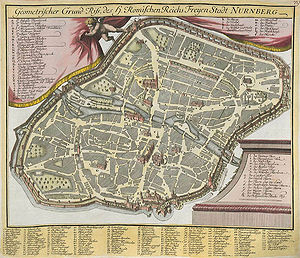
However, the late bloom around 1600 is at the same time marked by the withdrawal of the patricians from the imperial city's trade. The patriciate was replaced by bourgeois merchants and increasingly by non-nationals – in particular Dutch and Italians. Their economic success and therefore the international significance of Nuremberg and the goods produced by Nuremberg's craftsmen can be traced up until the 1630s. The merchants organised themselves with the approval of the Council, forming the trade board in 1560/66. At their insistence, the Council set up a Banco Publico in 1621, an exchange and clearing bank with a banking obligation for all business transactions over 200 gulden.
Economic decline during the Thirty Years' War and mercantilism
In its second decade, the Thirty Years' War hit the imperial city with full force. The quartering of the Swedish and repeated imperial attacks, intensified by recurring waves of the plague, devastated the land territory and decimated the population. Between 1632 and 1635, 25,000 people fell victim to war and epidemics in Nuremberg alone.
Devastation, a decline in the population and the paralysis of trade due to decades of warfare caused Nuremberg's economic power to dwindle. The burgeoning of mercantilism undermined the basis of Nuremberg's economy and thus prevented an upswing like the one after the Margrave Wars. The end of the war saw the city in its old role as one of the political centres of the empire for one last time. In 1649/50 a diplomatic congress, accompanied by glittering celebrations, discussed and decided on the implementation of the Peace of Westphalia provisions.
But architecture and culture experienced a late heyday even after the great War: Secular Baroque found its way into the large patrician and bourgeois gardens outside the city walls, and the Protestant imperial city made a significant contribution to Middle Franconia's Baroque sacred architecture with the rebuilding of the St. Egidien church, which was destroyed by fire at the beginning of the 18th century.
Standstill and decline in the 17th and 18th century

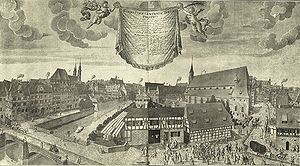
At the same time though, the imperial city's social life and legal order had come to a complete standstill. The patriciate was elevated to a closed fraternity of nobles in 1696 by Emperor Leopold I (ruled 1658-1705). The merchants increasingly opposed the economic and financial policies of the patrician dynasties and brought permanent lawsuits against the Council before the Aulic Council (Court Council of the Empire) regarding the city’s tax practices, but failed to achieve any significant results.
The desolate situation of the city's finances finally forced reforms. In 1794 the city was given a new constitution in the "Basic Treaty": now merchants and craftsmen were given a political say, for the first time since the Nuremberg Council Constitution came into force. In 1797, Emperor Franz II (ruled 1792-1806) set up a sub-delegation for a modern reorganisation of Nuremberg's administration and finances. However, these reform efforts came too late.
Annexation by Bavaria in 1806
Nuremberg had managed to escape mediatisation by the Final Recess of the Imperial Deputation in 1803. However, once Bavaria had taken over the principality of Ansbach from Prussia, its first King Max I Joseph (ruled 1806-1825) occupied the imperial city in September 1806 based on the Treaty of the Confederation of the Rhine.
References
- Gerhard Pfeiffer (Hg.), Nürnberg – Geschichte einer europäischen Stadt, Nürnberg 1971.
- Michael Diefenbacher/Rudolf Endres, Stadtlexikon Nürnberg, Nürnberg 2. Auflage 2000 (auch online).
- Martin Schieber, Nürnberg - Eine illustrierte Geschichte der Stadt, München 2000 (populärwissenschaftliche Überblicksdarstellung).
- Nürnberger Forschungen, seit 1941.
- Nürnberger Werkstücke zur Stadt- und Landesgeschichte, seit 1970.
- Quellen und Forschungen zur Geschichte und Kultur der Stadt Nürnberg (QNG), seit 1959.
Sources
- The inventory of the City and State Archives in Nuremberg are relevant.
Further Research
External Links
Related Articles
- Hausbücher der Nürnberger Zwölfbrüderstiftungen
- Nuremberg, Imperial City: Territory
- Nürnberg, Reichsstadt: Handwerk
- Akademie der Bildenden Künste in Nürnberg
Cite
Michael Diefenbacher, Nuremberg, Imperial City: Political and social development, published 09 March 2010, English version published 06 March 2024; in: Historisches Lexikon Bayerns, URL: <https://www.historisches-lexikon-bayerns.de/Lexikon/EN:Nuremberg,_Imperial_City:_Political_and_social_development> (15.12.2025)
